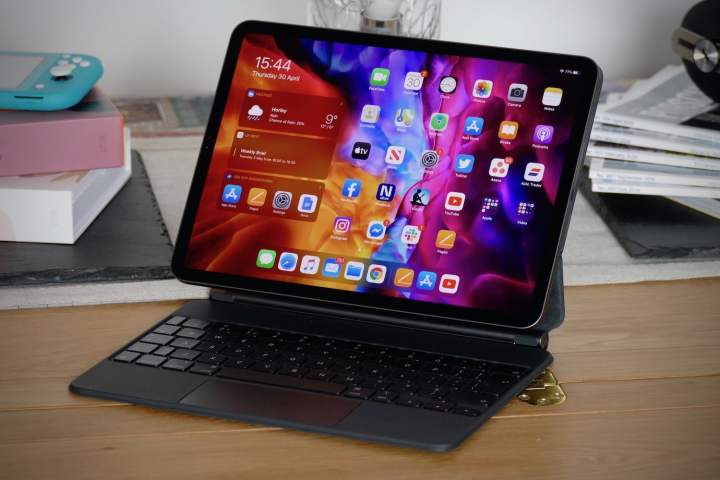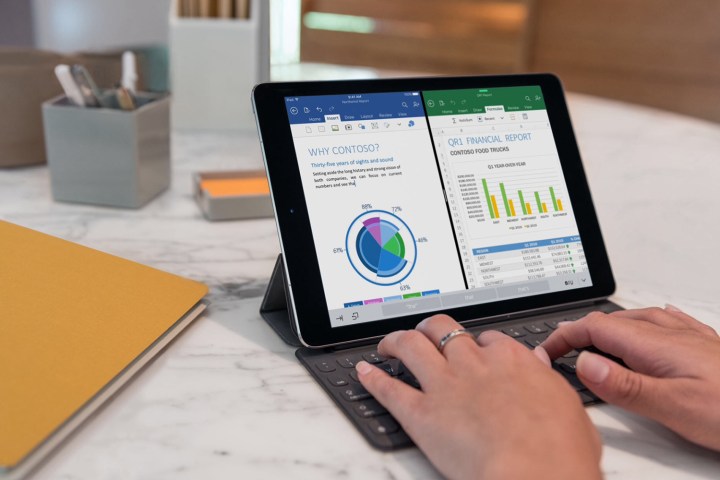The launch of a new iPad Pro range never fails to get our blood pumping — but it’s not the upgraded tablets that have really caught our eye this year. While the upgraded internals and camera module are impressive, it’s fair to say that, for most people, Apple’s new Magic Keyboard is the most exciting addition to the iPad Pro stable.
With a trackpad and floating cantilever mechanism, the Magic Keyboard is a stunning piece of kit — but is it really worth the much higher price over Apple’s more traditional offerings? Well, we’re going to put the new Magic Keyboard up against Apple’s Smart Keyboard Folio, marking the two keyboards in several categories. We’ll also reveal whether there are any options outside of Apple’s walled garden that may be worth your consideration.
Design
- 1. Apple Magic Keyboard
- 2. Apple Smart Keyboard
The Magic Keyboard is probably Apple’s most visually stunning product launched so far this year. It attaches magnetically to the back of the iPad Pro, and uses a cantilever mechanism to create a floating effect, where the iPad hovers over the backlit keyboard. To say it’s visually impressive is an understatement. The cantilever is adjustable, so you can alter it to fit your needs, and the magnetic attachment means it’s easy to attach and detach your iPad in a hurry. In a first for any iPad, there’s a sizeable trackpad nestled beneath the keyboard, and there’s a separate USB-C port with passthrough charging, so you can use other accessories at the same time.
By contrast, the Smart Keyboard Folio is a much more traditional affair. It also attaches magnetically to the iPad Pro’s pogo pins, but has a lot more in common with more regular keyboard cases. The tablet rests just behind the backlit keyboard and can be positioned at two angles. The case’s protection extends up the back of the tablet, and can fold down into a protective folio — hence the name. As such, it’s a great option if you take your iPad out a lot.
The Smart Keyboard Folio has a certain subtle style that we like, but the Magic Keyboard’s dazzling design and floating mechanism win the day.
Winner: Apple Magic Keyboard
Keyboard

But a beautiful design means nothing if the keyboard’s keys are mushy. Thankfully, that isn’t a problem. Apple’s Magic Keyboard feels great, and certainly won’t disappoint anyone who likes a great keyboard. Each key rests on a scissor mechanism and has 1mm of travel.
Apple has a lot to prove where the iPad keyboard experience is concerned because it hasn’t exactly covered itself in glory. We haven’t generally been fans of Apple’s tablet keyboards, and we found the Smart Keyboard Folio’s keyboard lacked a satisfying typing feel. While not the worst keyboard around, it was far from the best.
While we’re confident the Magic Keyboard will live up to Apple’s promises, we’re loathe to award it the win before we’ve had a chance to play with it a little. This stays a tie — for now.
Winner: Tie
Special features

Outside of being a full keyboard, there’s not much in the way of special features built into the Smart Keyboard Folio. However, one of the few advantages it has over other keyboards is its use of the iPad Pro’s pogo pins. Since it draws power and connects through those, there’s no need to charge an external battery or fiddle with your Bluetooth settings to get started.
The Magic Keyboard has that advantage, and more besides. The touchpad is a massive asset, and it would be enough to win the round by itself — but then you also factor the adjustable cantilever into the equation and it becomes ridiculously one-sided. The Magic Keyboard is Apple’s newest and most advanced keyboard, and it shows.
Winner: Apple Magic Keyboard
Price and availability
The Magic Keyboard is certainly impressive — but the admission price is steep. The Magic Keyboard for the iPad Pro 12.9-inch will set you back a staggering $349, and will work with the fourth and third-generation iPad Pro 12.9 — that’s the 2020 and 2018 models. The 11-inch iPad Pro version is cheaper, but only slightly, and will still cost you an eye-watering $299. It works with both versions of the iPad Pro 11-inch.
The Smart Keyboard Folio has the advantage of being a lot cheaper than the Magic Keyboard. The 11-inch version costs $179, while the 12.9-inch version will set you back $199 instead. The Smart Keyboard Folio will work with the 2020 and 2018 iPad Pro models.
Winner: Smart Keyboard Folio
The Apple Magic Keyboard is a clear winner, but is there a cheaper alternative?

Even if we haven’t had much chance to play with it yet, it’s pretty clear from its stunning design, new trackpad, and adjustable mechanism that the Apple Magic Keyboard is going to be the iPad Pro keyboard to beat this year — and it leaves the Smart Keyboard Folio in the dust. Really, the only reason to buy the Smart Keyboard Folio is that you balk at spending $300 on a keyboard.
But if that describes you, well, it’s worth keeping in mind there are other options outside of Apple’s store. Brydge has to be one of our top picks when looking for iPad keyboard cases, and it wasted no time in creating the Brydge Pro Plus. While it doesn’t use a fancy floating mechanism, Brydge’s unique attachment makes your iPad Pro look more like a MacBook, complete with a machined aluminum keyboard. It also features a trackpad, backlit keys, and three-month battery life. It’s currently available for pre-order, with release expected in mid-April. It costs $230 for the iPad Pro 12.9, and $200 for the iPad Pro 11.
Editors' Recommendations
- Does the iPad Pro (2024) come with a pen?
- The iPhone 16 Pro Max may get a very important battery upgrade
- Best refurbished iPad deals: Get an iPad with warranty for $109
- The iPhone 16 Pro Max could set a new record for the iPhone
- You’ll soon be able to control your iPhone and iPad with your eyes




